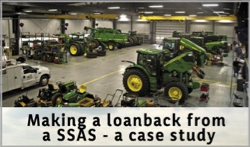Case study
Making use of the general fund
Mr Thomas runs a manufacturing facility and the business owns the factory. Mr Thomas’s wife, who acts as the Financial Director, suggests that the company can contribute into a pension scheme and this amount can be deducted from company profits and will reduce their corporation tax bill. This will provide a 19% tax saving on the amount paid.
It is recognised that the value of the company-owned factory will eventually find its way into their estates, so Mr and Mrs Thomas would also like to take advantage of any opportunity to transfer ownership away from their estates and therefore reduce their inheritance tax liability.
A SSAS is established with the trustees being the owners of the business, Mr and Mrs Thomas. Their business supplies parts to the building trade and is seasonal by nature. They are therefore not comfortable with contributing a large sum, in case it is required to sustain the business in leaner times. Therefore, rather than paying the contribution in cash, the company instead, transfers in the factory.
Ordinarily contributions are limited to £60,000 pa tax year 2023-2024 (formally £40,000 pa tax year 2022-2023) for an individual. However, it is recognised that both Mr and Mrs have historically been members of executive pension plans to which the company paid nominal contributions. Any unused allowance from each of the last three years can be ‘carried’ forward. However, this does not apply if they have enhanced protection or one of the forms of Fixed protection prior to 15/03/2023 and under which following the Spring Budget 2023 from 6 April 2023, they can now contribute. In that circumstance, there is no carry forward available from prior to 6 April 2023, the contributions can only commence from 6 April 2023.
This results in both Mr and Mrs Thomas having the ability to contribute £100,000 this tax year. However the property was valued at £280,000. This does not present a problem as £200,000 of the contribution was allocated to each of the members and the remaining £80,000 was allocated to the ‘general fund’. When the new tax year comes around this will open up a new allowance of £60,000 per member, and they can both have £40,000 allocated to each of them, with a remaining £20,000 each allocation available (i.e the amount sitting in the 'general fund') and this will be allocated between both members when the time arrives.
The company contributing £280,000 to a pension scheme for the two members was tax relievable as it was assessed to be ‘wholly and exclusively for the purposes of trade’.
Mr and Mrs Thomas are pleased to have been able to reduce their tax bill. They are also pleased that the factory is now held by their pension scheme and, in the worst case scenario, if creditors come calling on their business, the factory is protected and cannot be touched.





